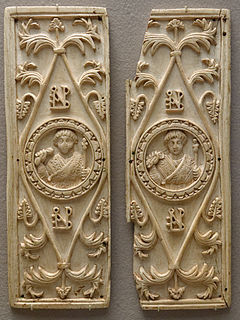 W
WA diptych is any object with two flat plates which form a pair, often attached by hinge. For example, the standard notebook and school exercise book of the ancient world was a diptych consisting of a pair of such plates that contained a recessed space filled with wax. Writing was accomplished by scratching the wax surface with a stylus. When the notes were no longer needed, the wax could be slightly heated and then smoothed to allow reuse. Ordinary versions had wooden frames, but more luxurious diptychs were crafted with more expensive materials.
 W
WAdam and Eve is a pair of paintings by German Renaissance master Lucas Cranach the Elder, dating from 1528, housed in the Uffizi, Florence, Italy. There are other paintings by the same artist with the same title, depicting the subjects either together in a double portrait or separately in a pair of portraits, for instance at the Kunsthistorisches Museum in Vienna, the Courtauld Gallery in London, the Museum der bildenden Künste in Leipzig, and the Art Institute of Chicago.
 W
WAdam and Eve is the name of two works by German Renaissance artist Albrecht Dürer: an engraving made in 1504, and a pair of oil-on-panel paintings completed in 1507.
 W
WThe Annunciation is an oil on wood in grisaille painting by the Early Netherlandish artist Jan van Eyck, dated by art historians as between 1434 and 1436. The panels form a diptych, and are currently in the collection of the Museo Thyssen-Bornemisza, Madrid.
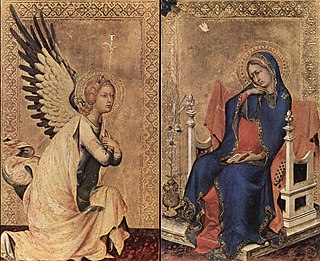 W
WThe Annunciation Diptych or the Orsini Altarpiece is a two-panel tempera on panel altarpiece painted in 1333 by Simone Martini, now in the Royal Museum of Fine Arts, Antwerp, to which it was bequeathed by Florent van Ertborn, mayor of Antwerp, along with other works by the same artist.
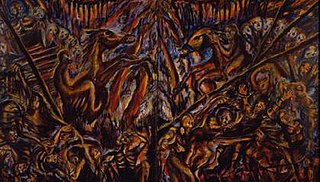 W
WApocalyptic Riders is a diptych executed in 1984 and is part of a series begun in 1980 by Nabil Kanso.
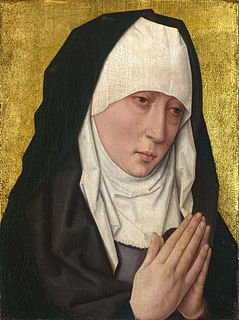 W
WThe Christ and the Virgin Diptych consisted of two small oil on oak panel paintings by the Early Netherlandish painter Dirk Bouts completed c. 1470–75. Originally they formed the wings of a hinged devotional diptych.
 W
WThe Crucifixion and Last Judgement diptych consists of two small painted panels attributed to the Early Netherlandish artist Jan van Eyck, with areas finished by unidentified followers or members of his workshop. This diptych is one of the early Northern Renaissance oil on panel masterpieces, renowned for its unusually complex and highly detailed iconography, and for the technical skill evident in its completion. It was executed in a miniature format; the panels are just 56.5 cm (22.2 in) high by 19.7 cm (7.8 in) wide. The diptych was probably commissioned for private devotion.
 W
WCrucifixion Diptych — also known as Philadelphia Diptych, Calvary Diptych, Christ on the Cross with the Virgin and St. John, or The Crucifixion with the Virgin and Saint John the Evangelist Mourning — is a diptych by the Early Netherlandish artist Rogier van der Weyden, completed c. 1460, today in the Philadelphia Museum of Art. The panels are noted for their technical skill, visceral impact and for possessing a physicality and directness unusual for Netherlandish art of the time. The Philadelphia Museum of Art describes work as the "greatest Old Master painting in the Museum."
 W
WAmong the paintings attributed to Giovanni da Rimini are two panels from a former diptych, dated to 1300–1305, of which the left wing is in the collection of the National Gallery, London, and the right that of the Galleria Nazionale d'Arte Antica, Palazzo Barberini, Rome.
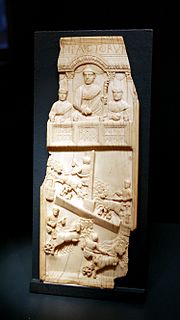 W
WThe Diptych of the Lampadii is an ivory diptych, measuring 27x9x2 cm) dating to the beginning of the Fifth century AD. Only the left plate, which is kept in the Museo di Santa Giulia in Brescia, survives.
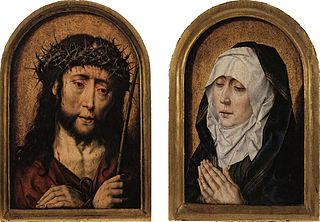 W
WThe Ecce Homo and Mater Dolorosa Diptych consisted of two small oil-on-panel paintings usually attributed to the Early Netherlandish artist Aelbrecht Bouts produced between 1491 – 1520. For many years they formed the wings of a hinged devotional diptych, but are now broken apart. Although their exact dating is unknown, the Ecce Homo panel, portraying Jesus bound and crowned with thorns, is thought to have been painted after 1491, while the Mater Dolorosa panel presents the Virgin Mary as Our Lady of Sorrows, and was painted after 1517. Both panels measure 45.5 x 31 cm, although the Mater Dolorosa is slightly larger at 31.1 cm wide. They are in the collection of the Suermondt-Ludwig-Museum, Aachen, Germany, where they are hung alongside each other.
 W
WIn Late Antiquity, an imperial diptych is a theoretical type of ivory diptych, made up of two leaves of five panels each and each with a central panel representing the emperor or empress. They are so-named in contrast to consular diptychs. They were produced as unique examples, whereas each consular diptych was produced in large numbers to offer to the emperor on certain occasions, principally a nobleman's entry to the consulship.
 W
WThe Judgement of Cambyses is an oil on wood diptych by Dutch artist Gerard David, depicting the arrest and flaying of the corrupt Persian judge Sisamnes on the order of Cambyses, based on Herodotus' Histories. The diptych was commissioned in 1487/1488 by the municipal authorities of Bruges which requested a series of panels for the deputy burgomaster's room in the town hall.
 W
WLiving Memory is the title of a series of 9 mural-size paintings on the Holocaust painted by Nabil Kanso in 1980, 1990 and 1993-94.
 W
WThe Marilyn Diptych (1962) is a silkscreen painting by American pop artist Andy Warhol depicting Marilyn Monroe.
 W
WThe Melun Diptych is a two-panel oil painting by the French court painter Jean Fouquet created around 1452. The name of the diptych came from its original home in the Collegiate Church of Notre-Dame in Melun. The left panel depicts Etienne Chevalier with his patron saint St. Stephen and the right panel depicts the Virgin and Christ child surrounded by cherubim. Each wooden panel measures about 93 by 85 centimeters and the two would have been hinged together at the center. The two pieces, originally a diptych, are now separated. The left panel is now in the Staatliche Museen in Berlin and the right panel is now located at the Royal Museum of Fine Arts, Antwerp, Belgium. A self-portrait medallion is also associated with the two panels. Measuring 6 centimeters in diameter, it would have adorned the frame, and consists of copper, enamel, and gold. The medallion is now in the Louvre in Paris, France.
 W
WThe Poet and Muse diptych is a Late Antique ivory diptych that appears to commemorate, and to flatter, the literary pursuits of the aristocrat who commissioned it, so that it stands somewhat apart from the consular diptychs that were carved for distribution to friends and patrons when a man assumed the consular dignity during the later Roman Empire. The original inscription in this example, unusually, will have been carried out on the borders of the reverse side, which was infilled with a layer of wax for writing on, the ivory diptych being a very grand example of a wax tablet; the inscription has not survived, so there can be no way to identify the writer for whom it was made. In the literature that has accumulated about this diptych, various prominent figures have been offered as candidates: Ausonius, Boethius, and Claudian, and even earlier figures, like Ennius and Seneca, with whom the donor wished to be associated
 W
WPortrait Diptych of Dürer's Parents is the collective name for two late-15th century portrait panels by the German painter and printmaker Albrecht Dürer. They show the artist's parents, Barbara Holper and Albrecht Dürer the Elder, when she was around 39 and he was 63 years. The portraits are unflinching records of the physical and emotional effects of ageing. The Dürer family was close, and Dürer may have intended the panels either to display his skill to his parents or as keepsakes while he travelled soon after as a journeyman painter.
 W
WThe Diptych of Philip de Croÿ with The Virgin and Child consists of a pair of small oil-on-oak panels painted c. 1460 by the Netherlandish artist Rogier van der Weyden. While the authorship and dating of both works are not in doubt, it is believed but not proven that they were created as wings of a devotional diptych and that at some unknown time the panels were broken apart. A diptych panel fitting the description of the Mary wing was described in a 1629 inventory of paintings owned by Alexandre d'Arenberg, a descendant of Philip I de Croÿ (1435–1511). Both have been approximately dated to 1460 and are now in Antwerp and San Marino, CA respectively. The reverse of de Croÿ's portrait is inscribed with the family crest and the title used by the sitter from 1454 to 1461.
 W
WThe Queriniano diptych, called Dittico Queriniano in Italian, is a Late Antique ivory diptych that was likely made to celebrate a wedding.
 W
WThe Vienna Diptych or the Fall and Redemption of Man is a religious diptych by the Flemish artist Hugo van der Goes depicting the fall of man on the left panel and the lamentation of Christ on the right panel. Painted in the second half of the 15th century, the diptych is housed in the Austrian Kunsthistorisches Museum, Vienna.
 W
WThe Wilton Diptych is a small portable diptych of two hinged panels, painted on both sides, now in the National Gallery, London. It is an extremely rare survival of a late Medieval religious panel painting from England.